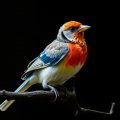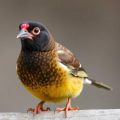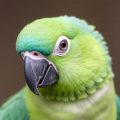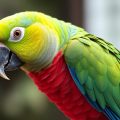Содержание
- What Is an Allergy — In Birds and in People?
- Can Birds Have Allergies? The Evidence and Mechanisms
- Common Allergens and Triggers for Parrots
- Recognizing Allergies: Signs and Symptoms to Watch For
- How Veterinarians Diagnose Allergies in Parrots
- Treatment Strategies for Allergies in Parrots
- Food Allergies vs. Food Intolerances
- Feather Plucking: Allergies or Something Else?
- Preventing Allergies and Reducing Risk
- When to See an Avian Veterinarian — Urgent Signs
- Case Examples: Practical Scenarios
- Common Myths and Misconceptions
- Practical Checklist: What Owners Can Do Today
- When Allergies Reflect Deeper Health Issues
- Resources and Further Reading
- Frequently Asked Questions
- Working with Your Avian Vet: Questions to Ask
- Key Takeaways: A Practical Summary
- Conclusion
SQLITE NOT INSTALLED
Parrots are chatterboxes, entertainers, and treasured companions for millions of people around the world. They greet us with squawks, mimic our words, and preen themselves into a dazzling display of color and personality. But just like people, parrots can suffer from health issues that are easy to misinterpret. One question that comes up often among bird owners is: “Allergies in parrots: can birds have allergies?” The short answer is yes — birds can react to environmental and dietary triggers in ways that resemble human allergies — but the longer answer is a little more complicated and worth unpacking carefully so you can recognize, manage, and prevent problems before they become serious.
Understanding what’s happening when a parrot responds poorly to something in its environment takes patience, observation, and a partnership with an avian veterinarian. In the next sections I’ll walk you through what allergies might look like in parrots, common triggers, how vets diagnose and treat allergic reactions, practical steps you can take at home, and how to distinguish allergies from other conditions that mimic similar signs. This is a conversational guide—think of it as a friendly walkthrough so you can feel confident spotting trouble and helping your feathered friend feel their best.
What Is an Allergy — In Birds and in People?
When people talk about allergies, they usually mean an immune system overreaction to a normally harmless substance — pollen, dust mites, pet dander, certain foods, medications, or insect venoms. The immune system identifies the substance (an allergen) as dangerous and mounts a cascade of chemical signals: histamine release, inflammation, and the familiar symptoms of sneezing, itching, rashes, or respiratory distress.
In birds, the immune system also exists to protect against infections and foreign invaders, and it can react in overzealous ways too. However, recognizing allergic disease in parrots requires careful observation because birds don’t sneeze, rub their eyes, or scratch their faces in the same way people do. Their signs are often subtle: changes in breathing, chronic sneezing, nasal discharge, frequent eye irritation, excessive preening or feather picking, changes in stool, or even a drop in activity and appetite. Some of these signs overlap with infections, nutritional diseases, or toxic exposures, so a veterinarian’s evaluation is essential.
Can Birds Have Allergies? The Evidence and Mechanisms
Yes — birds can have hypersensitivity reactions. Research and clinical experience in avian medicine document several types of immune-mediated responses in birds:
- Type I hypersensitivity (immediate, IgE-mediated) — similar to classic human allergies such as pollen or food reactions. These can lead to respiratory signs or skin irritation.
- Type II and III hypersensitivities — immune complex-mediated disorders that can affect organs and joints in different ways.
- Delayed-type hypersensitivities (Type IV) — T-cell mediated responses that may cause chronic inflammatory changes.
Although detailed allergy testing and research in parrots is less extensive than in dogs, cats, or humans, avian clinicians commonly encounter allergic-type conditions. For example, birds living in dusty environments often develop chronic respiratory disease, and feather-destructive behavior can be triggered or worsened by environmental irritants.
Common Allergens and Triggers for Parrots
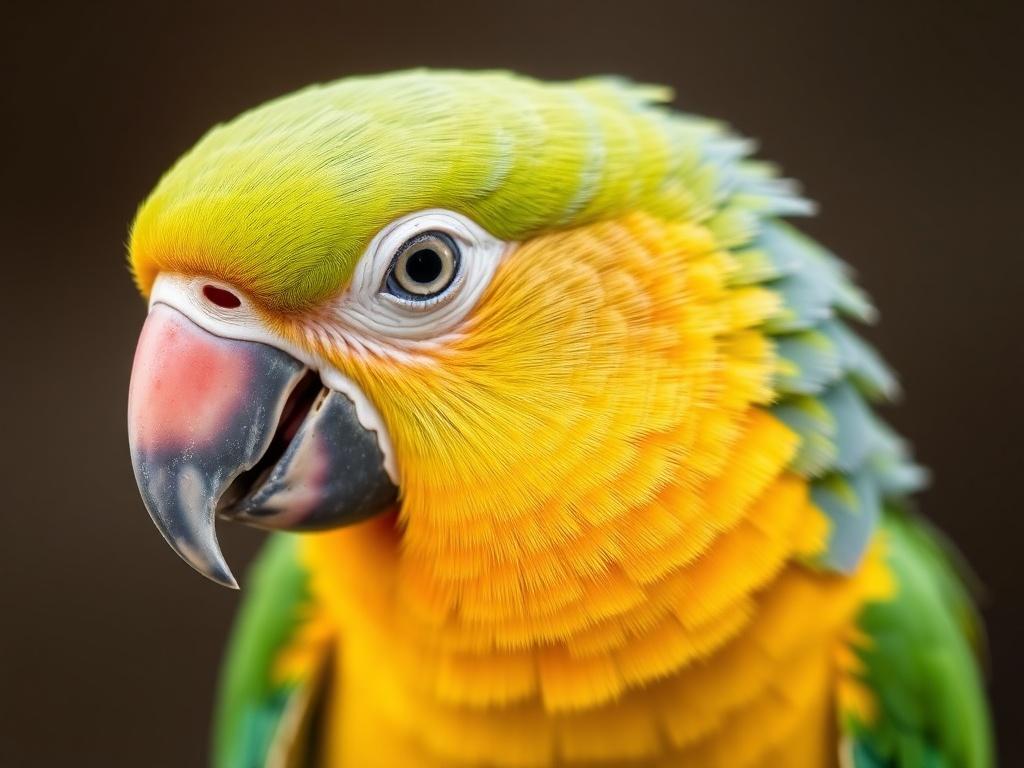
Parrots live in our household environments, and that exposes them to a host of potential irritants. Some triggers are obvious, others are sneaky. Below is a practical table showing common allergens, how parrots might be exposed, and example signs to watch for.
| Allergen/Trigger | How Exposure Occurs | Possible Signs in Parrots |
|---|---|---|
| Feather dust and dander | Natural flakes from feathers, especially in cockatoos, cockatiels, African greys | Chronic sneezing, wheezing, upper respiratory noise, irritated eyes |
| Pollen | Open windows, plants, flowers brought into the home | Sneezing, watery eyes, increased respiratory effort |
| Mold and fungus | Humid environments, damp bedding, contaminated seed or food | Chronic respiratory disease, lethargy, poor appetite |
| Household sprays and cleaners | Aerosol cleaners, air fresheners, scented candles | Acute respiratory distress, coughing, collapse in severe cases |
| Tobacco smoke | Exposure in the home or outdoors | Chronic respiratory disease, increased susceptibility to infections |
| Food ingredients | Seeds, nuts, additives, colored treats | Diarrhea, vomiting, feather picking, itching |
| Parasites (mites) | Contact with wild birds or contaminated items | Itching, feather damage, restlessness |
| Medications and vaccines | Injections or oral drugs administered by owners/veterinarians | Acute reactions, hives (rare), collapse |
Feather Dust: A Unique Parrot Issue
Many parrot species — especially cockatoos, cockatiels, and amazons — produce microscopic powder during preening that helps waterproof and condition feathers. That powder can float in the air and irritate the respiratory tract and skin. Bird owners often confuse this with dandruff. For sensitive birds or those with pre-existing respiratory disease, feather dust can be a significant problem.
Indoor Environmental Hazards
Cooking fumes, scented products, incense, heated nonstick cookware (the infamous teflon-associated toxicosis), and incense smoke can all cause respiratory irritation or acute toxicity for birds. Even “natural” products like essential oils can be dangerous: birds have sensitive respiratory systems and different metabolic pathways, so essential oil exposure is best avoided.
Recognizing Allergies: Signs and Symptoms to Watch For
Because parrots mask illness very well — a survival trait in the wild — owners must learn to notice subtle changes. Allergic or allergic-like disease may present in multiple ways. Here are signs to watch for, grouped by system.
- Respiratory signs: sneezing, nasal discharge, tail bobbing, wheezing, clicking or rattling sounds when breathing, increased respiratory rate, open-mouth breathing in severe cases.
- Skin and feather changes: dermatitis, red or inflamed skin, feather picking or plucking, broken or poor-quality feathers, increased preening.
- Eyes and face: watery or swollen eyes, red conjunctiva, rubbing or squinting.
- Digestive signs: vomiting, diarrhea, changes in stool color/consistency, decreased appetite when a food allergy is present.
- Behavioral changes: increased irritability, lethargy, decreased vocalization, or heightened agitation associated with discomfort.
Note that many of these signs overlap with infections (bacterial, fungal, viral), toxic exposures, nutritional deficiencies, and hormonal or psychological problems. That’s why a veterinary evaluation is necessary.
How Veterinarians Diagnose Allergies in Parrots
Diagnosing allergies in parrots is not always straightforward. Veterinarians combine history, physical examination, diagnostic testing, and sometimes therapeutic trials to determine whether allergies are the likely cause.
History and environmental assessment
A detailed history is vital: How long have signs been present? Are they seasonal? Is there any change in diet, cleaning products, or household exposures? Do signs worsen during baths, near houseplants, or when new furniture or candles are introduced? This detective work often points toward likely triggers.
Physical exam and baseline diagnostics
The vet will perform a thorough exam and may recommend:
- Feather and skin exams for parasites or fungal infections.
- Cytology (microscopic examination) of nasal or tracheal secretions.
- Crop/stool cultures or fecal exams to rule out parasites.
- Blood work (CBC, biochemistry) to evaluate overall health and look for signs of infection or organ dysfunction.
- Radiographs (X-rays) to assess air sacs and lungs if respiratory signs are prominent.
Allergy testing — limitations and options
Skin testing and serum IgE testing are commonly used in dogs and people. In parrots, allergy testing is less standardized and results may be difficult to interpret. Some avian veterinarians may use intradermal testing or send serum for specific IgE testing, but these tests have limitations in birds and are not as widely validated. Often, vets rely on response to environmental changes or therapeutic trials to confirm suspicions.
Elimination and challenge trials
One pragmatic approach is an elimination trial: remove suspected allergens (like a certain food, a cleaning product, or a houseplant), and watch for improvement. Reintroducing the item (challenge) can confirm the trigger if symptoms recur. This method is useful for food-related issues or clearly identifiable environmental agents.
Treatment Strategies for Allergies in Parrots
Treatment is twofold: remove or reduce exposure to the trigger(s) and manage the bird’s symptoms. Because parrots can deteriorate quickly with respiratory compromise, quick action is sometimes needed.
Environmental management and allergen avoidance
Reducing exposure can dramatically improve your bird’s quality of life. Practical tips include:
- Improve air quality: use HEPA air purifiers (bird-safe), avoid aerosols, open windows cautiously when pollen counts are low.
- Remove mold sources: fix leaks, dry damp areas, discard moldy food/seeds, use low-humidity bedding if advised.
- Minimize feather dust exposure: regular gentle baths, cage air filters, and keeping the cage away from high-traffic dust-producing zones.
- Stop smoking and ban scented candles, incense, and essential oil diffusers near birds.
- Switch to unscented, bird-safe cleaners and avoid aerosol sprays.
Medications and supportive care
Depending on the severity and type of reaction, vets might prescribe:
- Antihistamines — sometimes used but their efficacy is variable in birds and dosing must be done by an avian vet.
- Systemic corticosteroids — effective anti-inflammatory agents used for severe allergic reactions, but they carry risks (immune suppression, weight gain, behavioral changes, liver strain) and should be used cautiously and for the shortest effective duration.
- Inhaled medications — nebulized saline or bronchodilators may help clear secretions and open airways under veterinary guidance.
- Antibiotics or antifungals — used only when a secondary infection is identified or strongly suspected.
Never give human over-the-counter medications to a bird without consulting an avian veterinarian — many drugs and doses safe for humans are harmful or lethal to birds.
Behavioral and supportive strategies
When allergies drive feather plucking or obsessive preening, enrichment and stress reduction can be part of management:
- Offer toys, foraging puzzles, and social interaction to reduce boredom-driven plucking.
- Provide regular bathing opportunities; for many parrots, baths help reduce feather dust and soothe skin.
- Consider environmental enrichment, music, or increased out-of-cage time under supervision to reduce stress.
Food Allergies vs. Food Intolerances
Food-related problems in parrots can be immune-mediated (true allergies) or non-immune reactions (intolerances). Food allergies typically involve an immune response to a protein, leading to skin or gastrointestinal signs. Food intolerances may cause digestive upset but do not involve the immune system.
To investigate suspected food reactions, vets typically recommend an elimination diet using a novel or hydrolyzed protein source for several weeks, followed by careful reintroduction to identify triggers. Note: sudden diet changes without guidance can cause more harm than good; consult your avian vet for a safe elimination protocol.
Feather Plucking: Allergies or Something Else?
Feather plucking is an alarmingly common sign and a common reason owners ask about allergies. While allergies can lead to itching and plucking, many other causes exist: behavioral problems (boredom, lack of stimulation), pain, nutritional deficiencies, hormonal imbalances, bacterial or fungal skin disease, and even neurologic conditions.
A systematic approach is essential: rule out medical causes first with a vet check, then address behavioral and environmental factors. If an allergy is suspected, treating the underlying allergic condition and reducing irritating exposures often leads to improvement — but patience is key, because feathers take time to regrow.
Preventing Allergies and Reducing Risk
Complete prevention isn’t always possible, but you can reduce risk and severity by building a bird-friendly environment.
- Provide a balanced, species-appropriate diet to support immune health — many vets recommend pelleted diets supplemented with fresh vegetables rather than seed-only diets that can be dusty and nutritionally unbalanced.
- Keep living spaces clean and dry to avoid mold growth and dust accumulation; regular gentle cleaning of cages and areas around them helps.
- Use bird-safe cleaning products and refrain from spraying chemicals near the cage. Avoid aerosols altogether.
- Establish an indoor air-quality routine: HEPA filters, moderate humidity, and good ventilation (without exposing birds to direct drafts or outdoor pollution) help keep airborne irritants low.
- Monitor seasonal pollen counts if you suspect pollen sensitivity and limit outdoor cage time or open windows during high-pollen days.
When to See an Avian Veterinarian — Urgent Signs
Some allergic or allergic-like reactions can escalate quickly. Seek immediate veterinary care if your parrot shows:
- Open-mouth breathing, gasping, or very rapid breathing.
- Sudden collapse or inability to stand.
- Bleeding, severe swelling of the face or throat, or obvious signs of anaphylaxis.
- Severe lethargy, refusal to eat, or dramatic changes in behavior.
Less urgent — but still important — concerns include chronic sneezing, ongoing nasal discharge, progressive feather destruction, or subtle changes in droppings or vocalization.
Case Examples: Practical Scenarios
Real-life scenarios help make theory practical. Here are a few common situations and reasonable owner and vet responses.
Scenario 1: Seasonal Sneezing in a Budgie
A budgie begins sneezing frequently every spring when the owner opens windows. The vet suspects pollen sensitivity and recommends limiting open windows during high pollen days, adding a HEPA filter near the cage, and giving the bird supervised outdoor time in a low-pollen setting. Symptoms improve after a few weeks.
Scenario 2: New Air Freshener Causes Acute Distress
An African grey experiences sudden respiratory distress after the owner sprays an air freshener. The owner removes the bird from the room, opens windows, and takes the bird to the vet. The vet provides oxygen support and nebulization; the bird recovers after avoiding the product in future.
Scenario 3: Feather Plucking and a Complex Cause
A cockatoo is plucking feathers. The vet rules out parasites and nutritional deficiencies, finds mild airway inflammation, and the owner notes heavy use of incense at home. After stopping incense, improving diet, adding enrichment, and a short course of anti-inflammatory therapy, the bird’s feathers begin to regrow over months.
These scenarios show how removal of triggers, veterinary care, and environmental changes often work together to restore health.
Common Myths and Misconceptions
There are a few myths owners frequently believe about allergies in parrots:
- Myth: Birds can’t have allergies because they don’t sneeze like humans.
Reality: Birds show respiratory and skin signs in species-specific ways; they do get allergic reactions. - Myth: Essential oils are safe because they are natural.
Reality: Many essential oils are highly irritating or toxic to birds and should be avoided. - Myth: Feather plucking is always behavioral.
Reality: It can be medical, behavioral, or both; a vet should evaluate it.
Practical Checklist: What Owners Can Do Today
If you suspect your parrot is experiencing allergy-like issues, here’s a practical step-by-step checklist you can follow right now.
- Observe and document: note when signs started, what seems to make them better or worse, diet changes, and household product use.
- Remove obvious irritants: stop using aerosols, scented products, and avoid smoke near the bird.
- Improve hygiene: clean the cage regularly, throw away moldy food, and consider a HEPA filter near the bird.
- Offer baths: regular misting or shallow baths to reduce feather dust (if the bird tolerates it).
- Schedule a vet visit: get a professional assessment and baseline diagnostics before using medications.
- Follow the vet’s treatment and follow-up plan closely, and keep a log of improvements or relapses.
When Allergies Reflect Deeper Health Issues
Sometimes allergic signs are a symptom of a larger systemic problem. Chronic respiratory disease can predispose birds to secondary infections; immune dysfunction can make allergies worse; nutritional deficiencies may mimic or worsen dermatologic signs. This is why a holistic approach that considers diet, environment, behavior, and medical testing gives the best outcomes.
Resources and Further Reading
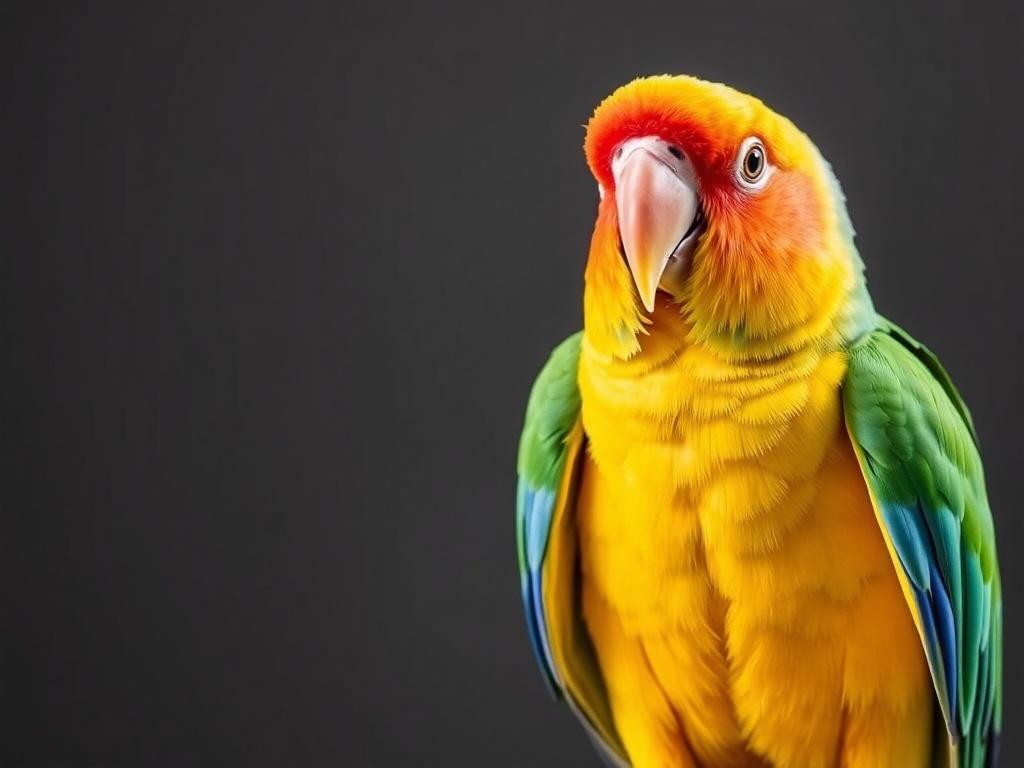
Reliable resources include avian veterinarians, avian-specific veterinary texts, and reputable bird organizations that publish care guidelines. Local avian clinics can also help owners create bird-safe home plans and identify environmental hazards specific to a region (mold species, pollen types, or common household toxins).
Frequently Asked Questions
Q: Can I test my parrot for allergies at home?
A: No. Home “tests” are not reliable. Work with an avian veterinarian for proper assessment and testing if indicated.
Q: Are antihistamines safe for parrots?
A: Some antihistamines are used in birds, but dosing varies by species and individual health. Always consult a vet before giving any medication.
Q: Will my parrot outgrow allergies?
A: Some sensitivities may change over time, but many environmental allergies persist without ongoing management and avoidance.
Q: Is feather dust harmful to humans?
A: Feather dust can be an irritant for sensitive people, too, but its impact is typically greater for birds because it directly contacts their respiratory systems.
Working with Your Avian Vet: Questions to Ask
When you see an avian vet, consider asking:
- What diagnostic tests do you recommend and why?
- Could this be a food allergy, environmental allergy, or infection?
- What immediate steps can I take at home to reduce symptoms?
- What medications might be effective and what are their risks?
- How will we monitor progress and know if the treatment is working?
Key Takeaways: A Practical Summary
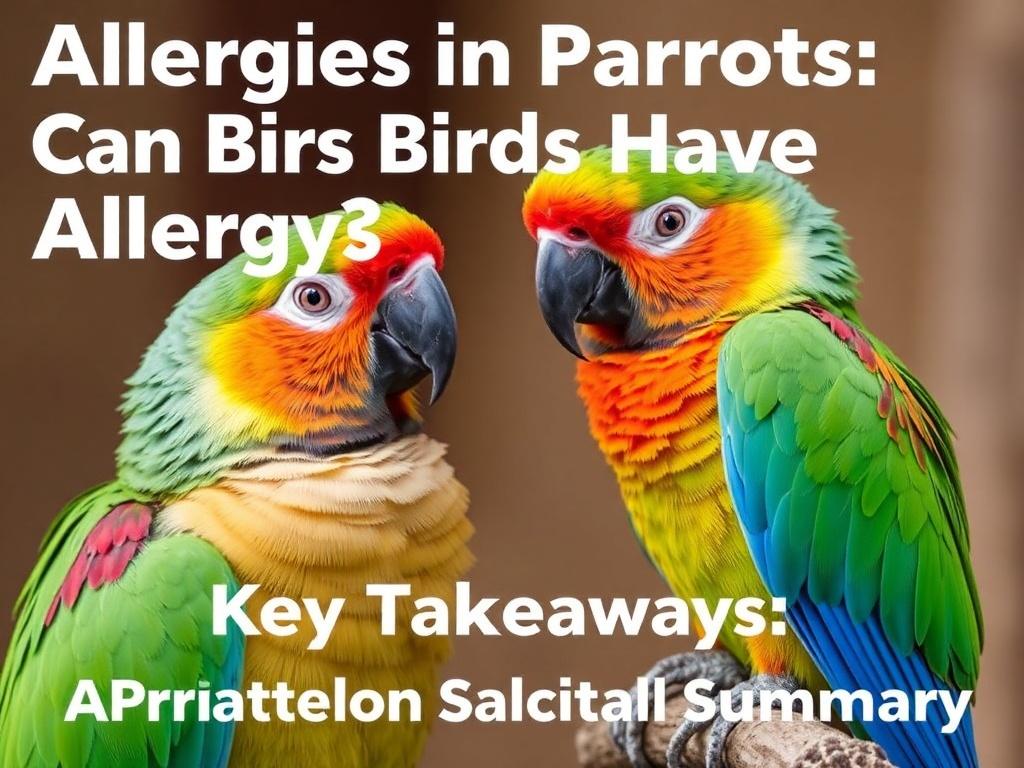
Parrots can indeed have allergies and allergy-like reactions. Their clinical signs are often respiratory or dermatologic and can be subtle. Diagnosis relies on a thorough history, clinical exam, targeted testing, and sometimes elimination trials. Treatment prioritizes removal of triggers and careful use of medications guided by an avian veterinarian. Preventive measures—improving air quality, avoiding toxic products, maintaining a balanced diet, and providing enrichment—go a long way toward reducing risk and improving your bird’s long-term health.
Conclusion
Allergies in parrots are real and, while sometimes tricky to diagnose, manageable with careful observation, environmental adjustments, and veterinary guidance. If you suspect your bird is having allergic reactions, document the signs, remove obvious irritants, and consult an avian veterinarian. With patience and a thoughtful plan, many parrots can return to comfortable, active lives — and you can enjoy many more shared moments with your bright, chatty companion.


